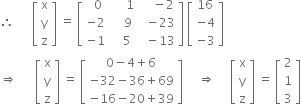 Long Answer Type
Long Answer TypeIf ![]() find A-1, Using A-1, solve the following system of linear equations.
find A-1, Using A-1, solve the following system of linear equations.
2x – 3y + 5z = 16
3x + 2y – 4z = – 4
x + y – 2z = – 3
Here,
![]()

Co-factors of the elements of first row of | A | are![]()
i.e. 0, 2, 1 respectively
Co-factors of the elements of second row of | A | are![]()
i.e., –1, –9 , –5 respectively.
Co-factors of the elements of third row of | A | are![]()
i.e., 2, 23, 13 respectively.
The given equations are
2x – 3y + 5z = 16
3x + 2y – 4z = – 4
x + y – 2z = – 3
These equations can be written as
![]()
![]()
![]()

![]()
If ![]() find A –1 .
find A –1 .
Using A–1, solve the following system of linear equations.
2x – 3y + 5z = 11
3x + 2y – 4z = – 5
x + y – 2z = – 3
Compute A–1 for the following matrix ![]()
Hence solve the system of equations.
– x + 2y+ 5 z = 2
2x – 3y + Z = 15
– x + y + z = – 3
Compute A–1 for the following matrix![]()
Hence, solve the system of equations:
x + 2y + 5z = 10
x – y – z = – 2
2x + 3y – 2z = – 1
If ![]() Find A–1.
Find A–1.
Using A solve the following systems of linear equations:
3x – 2y + z = 2
2y + y – 3z = – 5
– x + 2y + z = 6.
 Short Answer Type
Short Answer TypeInvestigate for what values of a and b the simultaneous equations:
x + y + z = 6
x + 2y + 3z = 10
x + 2y + az = b have a unique solution.
 Long Answer Type
Long Answer TypeThe sum of three numbers is 6. If we multiply third number by 3 and add second number to it, we get 11. By adding first and third numbers, we get double of the second number. Represent it algebraically and find the numbers using matrix method.
